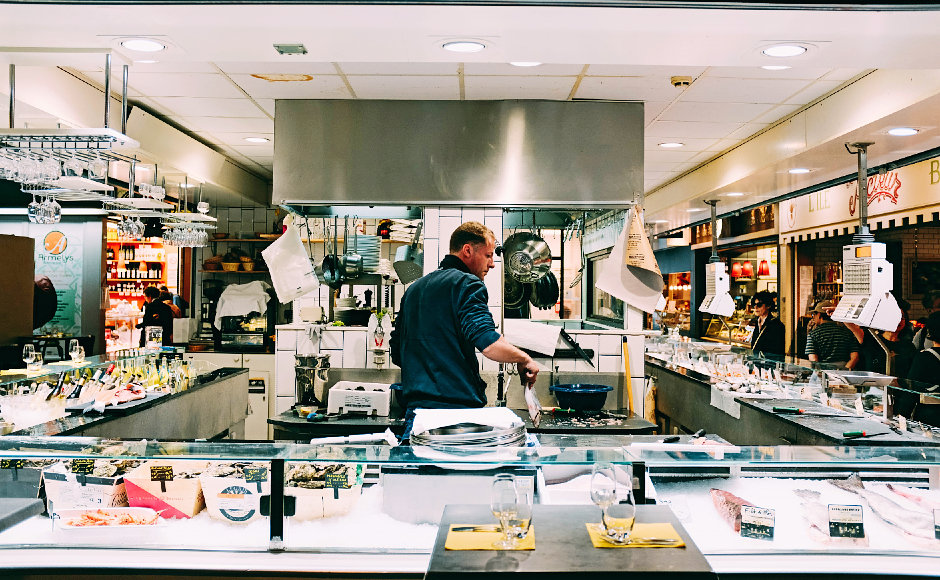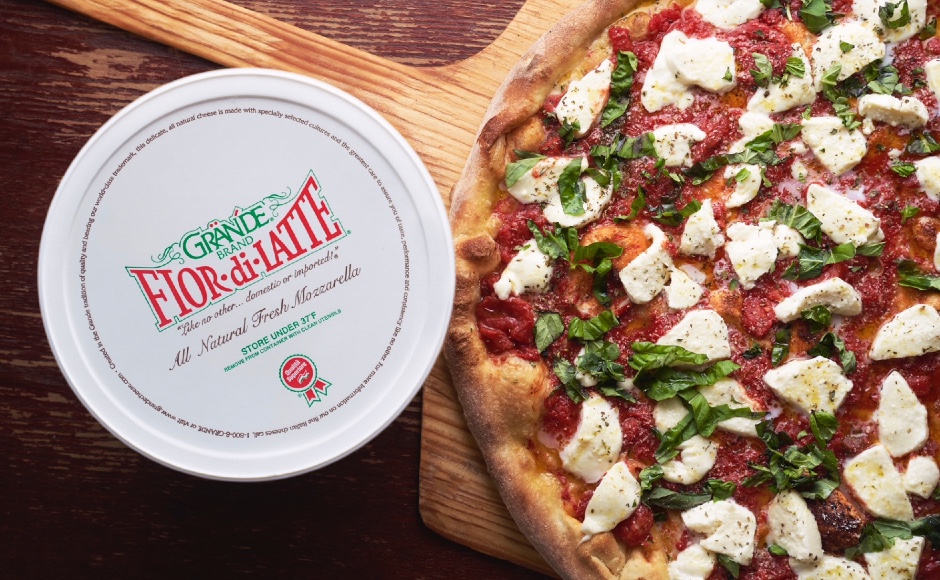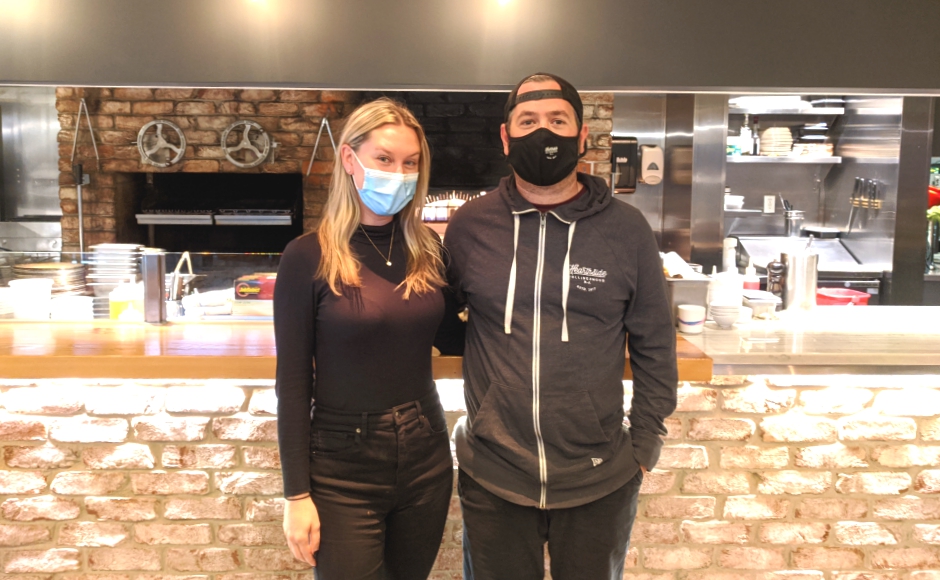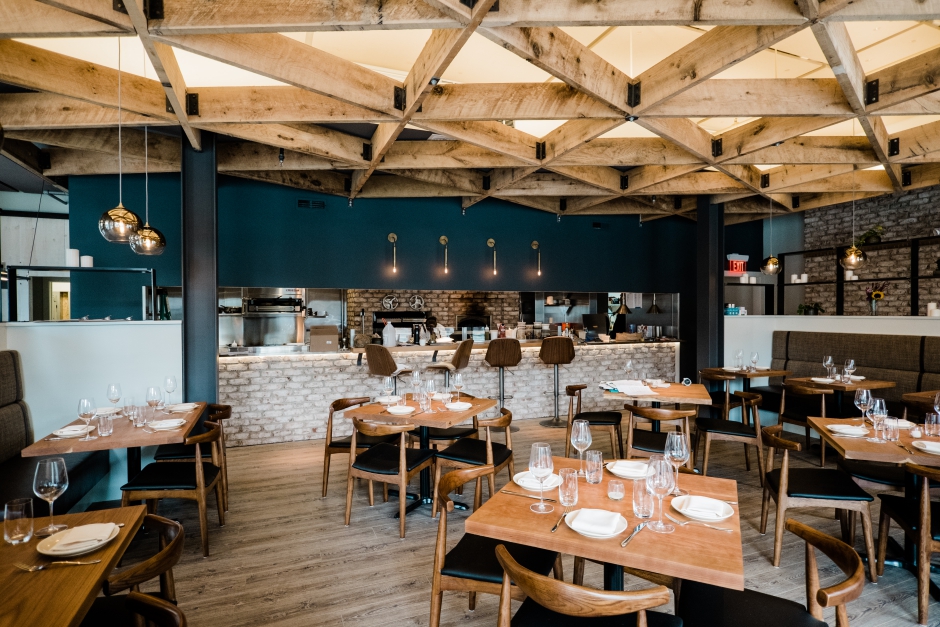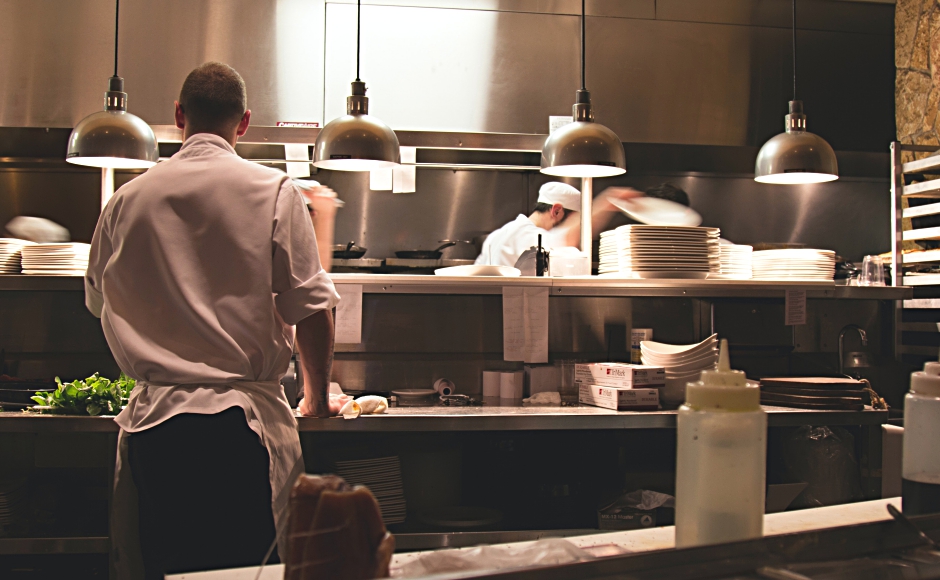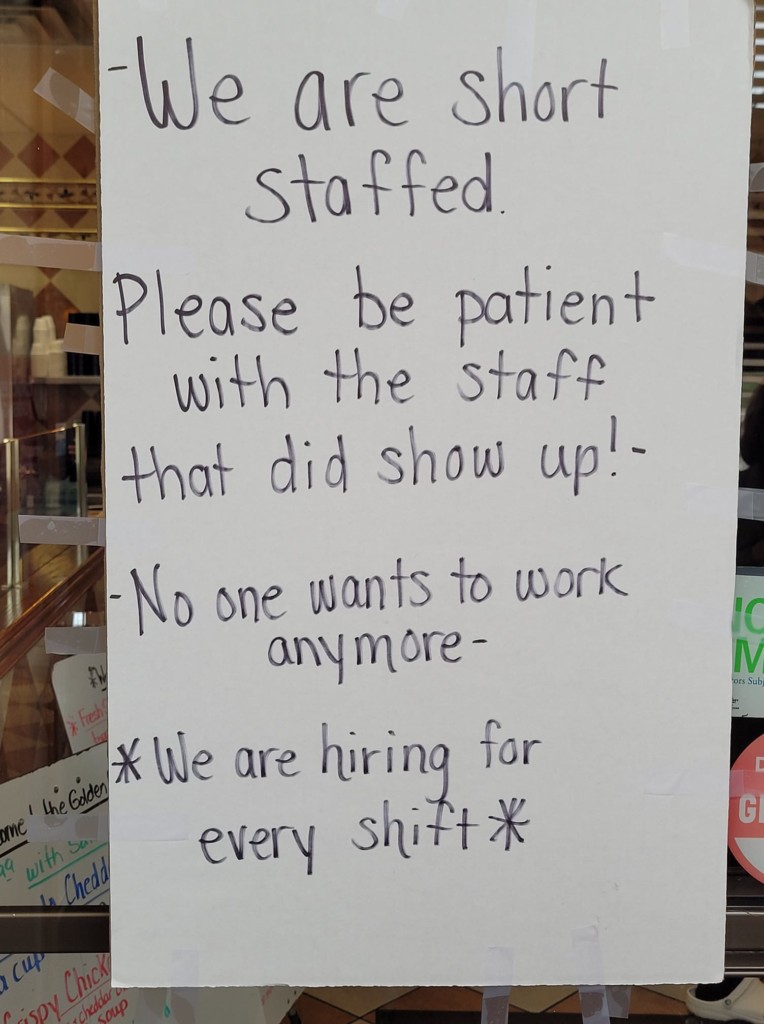From sandwich shops to fine dining, restaurateurs are faltering in their efforts to attract and retain talent at all positions. Some issues are structural, and others are temporary, but ideas for resolving them are few.
By Matt Skoufalos | April 16, 2021
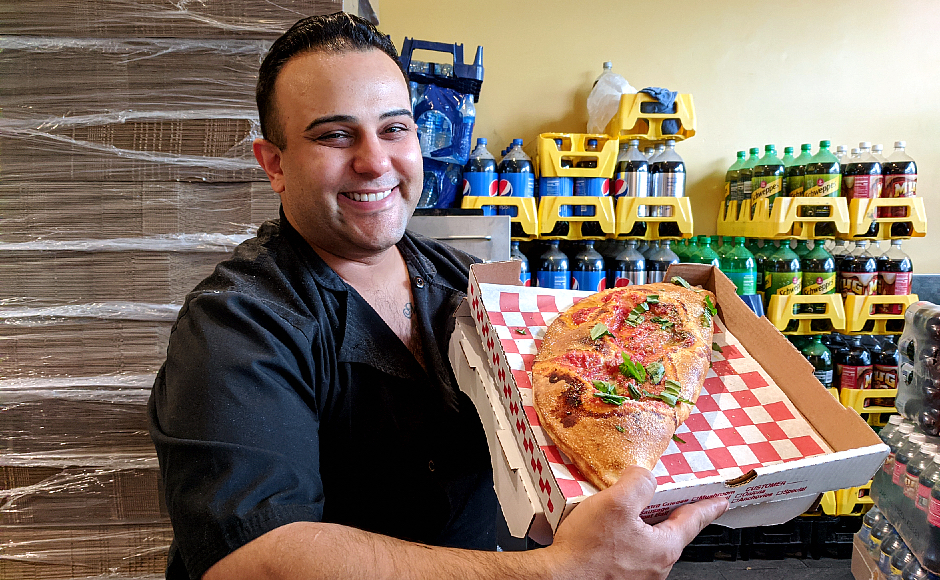
Filippo Sparacio of Brooklyn Pizza shows off the ripieno, a new menu item that’s like a fluffier calzone. Credit: Matt Skoufalos.
The two years since Fillipo Sparacio opened Brooklyn Pizza and Grill in Haddon Heights have been marked by increasing prosperity.
Since the Brooklyn-born, Sicilian-raised pizzaiolo has opened his doors, he’s drawn accolades from fans of his signature square pies, and grown an audience stretching from Philadelphia to the Jersey shore.
Demand for his product, plus its lengthy cooking times, led Sparacio to convert his dining room into an overflow area for prep work while he more than doubled his delivery radius.
And yet, one of the biggest, recent changes to the business—eliminating its expanded kitchen menu to focus on pizzas, calzones, and “everything that’s got to do with the dough”—wasn’t related to its growth, but rather a lack of new employees to support it.
“Business is continuously growing every day, every week,” Sparacio said. “People love our product. But in the pizza business, it’s been hard to find help the last 10 years. The last year, the pandemic, forget about it.
“The people I do have, I need them to focus on pizza,” he said. “I can’t sacrifice the quality on pizza.”
That attention to quality has led to some conversations with guests, even family members, Sparacio said, who raise an eyebrow at the prices of some menu items. That’s until he tells them that the fior de latte cheese he’s using doesn’t have added preservatives, or that the cured meats on the menu are brand-name.
Sparacio is comfortable with all those conversations because he believes they strengthen his brand among an audience that’s increasingly discerning about its pizza. It’s harder to tell people that it’ll be a longer wait for their food because he’s short-staffed.
“The pizza man, thank God I got the guy I got, but I wish I could find another pizza man,” Sparacio said. “Front of the house, thank God I’ve got my sister.
“You can’t grow a business of this volume when you’re by yourself,” he said. “When you’re behind that counter, everybody works together.”
Competition for the talent around which the shop revolves—even for new hires who must be trained to hand-stretch a pie and create that cornichone that only occurs by gently pushing the air from the dough to its edges—is fiercer than ever.
Even paying a seasoned pizzaiolo $16 to $20 an hour might not be enough to lure him away from warehouse work or corporate retail employment, Sparacio said.
And it’s a story he hears repeated among customers, too.
“In this business, you deal with the public all day long,” Sparacio said; “landscapers, construction. They don’t take on jobs because they don’t have the manpower to take them.
“That’s what it comes to with me over here,” he said. “All businesses connect; we’re all related. I had to close the kitchen down because you can only do so many things at high volume.
“You’ve come to the point where in order to hire these guys and compete with everything that’s going on in the world, you’d have to sell a $50 pizza,” Sparacio said. “You can’t just make a change like that from one day to another.”
‘How can I be that catalyst of change?’
Recruiting and retaining talent in the current economic landscape isn’t just something that affects a high-volume pizza shop like Brooklyn Pizza.
Dominic Piperno, chef-owner of Hearthside, a fine-dining BYOB in nearby Collingswood, said it’s a question with which he wrestles endlessly.
Piperno was “lucky enough” to have the bulk of his kitchen crew return to work when New Jersey expanded its capacity limits for indoor dining last month. Recently, however, the restaurant lost both its dishwashers, and it’s been a struggle to find replacements.
“Two years ago, if I lost one [dishwasher], I put an ad on Craigslist and had 25 people write me an e-mail,” Piperno said. “I have a friend in Philly, one of the best [chefs] in the city, and it took him seven weeks to find a line cook.
“I think that the lockdown, and the unemployment, plus the $600 [weekly federal pandemic unemployment assistance] shined a light on an industry that is probably in the wrong with the way we pay our staff,” he said. “But it’s the only way we can survive.”
The most successful restaurants typically enjoy only a 10-percent profit margin on costs that include brick-and-mortar overhead (rent, utilities, taxes, insurance, payment processing), consumable goods (raw ingredients, takeout containers), and labor and benefits. That’s also leaving out any financing costs on capital equipment (ovens, refrigerators) or fit-outs of the space.
Throughout the novel coronavirus (COVID-19) pandemic, food-based businesses have already felt significant upward pressure on ingredients, from produce to animal proteins, with additional costs tacked on for any imported goods. Business has been artificially suppressed by capacity limits during the public health emergency, which correspondingly limit revenues.
Factor in those conditions with a staffing shortage, and the cost of labor required to operate the business skyrockets, even among restaurateurs who compensate their help fairly well.
“We pay our staff a competitive wage in our industry,” Piperno said.
“It may not be competitive in the scale of the world, but unfortunately, it’s long hours, and the pay is not that great.
“The minute you start paying your staff $16, $17, $18 an hour, and they’re working 50 to 60 hours a week, labor costs go through the roof.”
Some operations, including corporate chains and restaurants in vacation communities that rely on seasonal business, can afford to overpay for staff, even above premium rates. Chef-owned BYOBs that line the storefronts of Haddon Avenue in Collingswood or Passyunk Avenue in Philadelphia can’t compete with that, Piperno said.
In response, places like Hearthside have closed an extra day per week, which Piperno notes further robs his staff of hours that would have earned them overtime pay. He’s hoping that his restaurant can simply weather the rest of the year at a break-even pace, until such time as it can reopen safely at full capacity.
“It’s just an odd, crazy time in our industry,” he said. “I sometimes think that I’m going to wake up one day and this year will just be over, but it seems like every day, there’s something else.
“I don’t disagree with the extra [unemployment] money; it was needed, people were not working,” he said. “The stimulus was all good things. I wish there was an [governmental] incentive for businesses to have more money to pay their employees more.”
To Piperno, a big part of the problem lies in the underlying structure of restaurant work. Hours are long and conditions are wearying, even among lifers who are passionate about their jobs. Labor in the business is inherently transient, too, with a high degree of turnover, even in boom times, for any number of personal or circumstantial reasons. The chef worries, however, that the fundamental nature of the job is starting to disillusion newcomers, even those with culinary education and grander aspirations of success.
“I feel like a life without a good passion is not really a true life at all,” Piperno said. “I don’t want some young kid who wants to be a chef, and owes money on loans to culinary school, to get to that first restaurant and be told he’s going to work at $11 an hour for a 50-hour week cleaning artichokes in the receiving line.

A mix of soft lights and hard surfaces give guests at Hearthside a number of sensory experiences. Credit: Tricia Burrough.
“I remember that life,” he said. “I wrestle with how I can be that catalyst of change.
“What can I do as a business owner that sets an example of offering your guests a premier product at a reasonable price and pay your staff a livable wage?”
Many BYOB restaurants like Hearthside could absolutely benefit from the revenue opportunity of selling alcohol that other establishments enjoy, but New Jersey liquor laws aren’t likely to change any time soon; plus adding alcohol service increases insurance costs and requires additional staff to tend bar, which doesn’t resolve the labor concerns.
At least one part of the solution starts with educating diners about industry economics, Piperno said. If he were to follow the lead of no-tip restaurants—eliminating gratuities, but charging more for meals to cover wage increases—Piperno worries that guests would balk at the price tags, or that servers would lose out on potentially greater earnings for giving their maximum effort.
“We have to educate our guests that sustaining a restaurant is expensive,” the chef said. “We would like to retain our staff, and pay their healthcare and benefits and time off: all the things we as individuals in this world deserve.
“The minute we start doing that, our pasta dishes go from $17 to $24; our half-chicken goes from $31 to $38,” he said. “Then you get labeled ‘an expensive restaurant,’ and you’re only eligible for special occasions and celebrations.
“I think the biggest thing is that this lockdown and unemployment plus the extra $600 shone a light on underpayment in the industry,” Piperno said. “Trying to get people back to work after the lockdown was over, people realized what their value is, and they want more money.
“For a restaurant that just lost nine months of income, unfortunately, a lot of us don’t have the money,” he said. “My guys came back because they know the future. Once we get back to full swing, and we open up the other place, there’s money to be had. I’m lucky that I have a line of chefs, not a line of cooks. They don’t see this as a job.”
‘The pandemic wasn’t the breaking point; the pandemic was halftime.’
Not every potential employee feels as positively about their work environment as the chefs at Hearthside, however.
Longtime restaurant consultant John Cohl said he’s spoken with restaurateurs across the region who’ve found that the talent pool from which they might historically recruit is self-selecting out of the food industry.
He related multiple anecdotes of restaurateurs being told by prospective hires that they could make more money livestreaming on services like OnlyFans and Twitch, or shorting stocks on Reddit, than they would sweating on the line in a hot kitchen—and in less time, too.
“[Business owners] explain about what’s required of them, and even at a higher pay rate, they say ‘this just isn’t worth it,’” Cohl said. “I think the industry has not recognized there are a ton of other options for people who want to work. They’re going to have to make the working conditions much less difficult, and I don’t know if that can be done.
“They’re not going to have to offer more money, they’re going to have to offer significantly more money,” Cohl said. “Asking people to work weekends, long hours, busting their ass, and you’re going to get the bulk of the money, it doesn’t resonate with them. You try to mentor someone, after a few months, they go off on their own.
“When you look at these sorts of things, I know there’s an ‘okay, boomer’ vibe to this, and maybe it’s unavoidable,” Cohl said. “There’s an economic mindset and a landscape that makes working in this industry unappealing. I think those stories of great chefs dying without a dime to their names, that resonates with people.”
Cohl chalks up some of the disconnect to systemic economic issues—wage stagnation and increased housing, fuel, and insurance costs—beyond the historically limited earning power of food service workers. But he also notes a societal shift in the definition of work, increasingly seen in terms of having a “hustle” and not a “job,” which has rewarded various, novel, and virtual ways of generating income.
“The conditions that let the restaurant industry to be staffed [cheaply] have eroded,” Cohl said. “Right now you have kids 30 and younger who are up, not just against a wall, but a forcefield.
“There’s not enough hours in the week for them to work,” he said.
“Food is super-expensive; gas, rent, are higher than they’ve ever been, but people are still in a minimum-wage scale from 15 to 20 years ago.
“It’s not the middle class that’s vanished, it’s the landscape that they stood on,” Cohl said.
“You can never save enough money, and the guy who owns the deli can never charge $37 for a hoagie,” he said.
“It’s starting to come apart. If a fast-casual chain is having trouble getting people to come in and wait tables or pour beers for $15 an hour, your local coffee shop has no chance.”
Like Piperno, Cohl believes that diners are going to have to get used to increasing costs as a reality of eateries striving to make up the labor shortfall. The alternative is to see more businesses shutting their doors for good.
“There’s no winning solution there,” he said. “There will be a breaking point. The pandemic wasn’t the breaking point; the pandemic was halftime. People are going to want to bum-rush their favorite places. They’re going to have to understand things are more expensive, or you stay home.”
‘No one wants to work anymore’
Chef-consultant Dave Murray, who recently stepped away from his Haddonfield BYOB, Denim, said staff shortages in the restaurant industry have become so bad that he’s been approached by his peers in the business to help with job placement—an offer he’s turned down simply because he can no longer reliably vouch for people he’s recommended.
“The days of, ‘I have a friend who’s a really good worker,’ those days are few and far between because nobody has friends who want to work,” he said.
“I don’t feel comfortable sending somebody your way because they’ll embarrass me.”
Murray chalks some of it up to the downtime that restaurant industry employees may have found during the pandemic.
He also believes workers have gotten savvier about their economic options in general.
“I thought restaurants were going to struggle because of the fear of corona,” Murray said. “I thought restaurants were going to struggle because of the [capacity] limitations. Now what’s happened is they’ve gotten past the majority of that and they can’t staff their restaurants; and it’s not just restaurants.
“Sometimes I feel like no matter how good you do, no matter how much you pay, it’s almost like you can’t pay anybody to give a f—,” he said. “Your workers are going to care a lot less about you than you do about them, and that’s the cold, hard truth about how things have changed.”
Murray does, however, take exception to the narrative that “no one wants to work anymore,” which some business owners have tried to spin as an answer for their difficulties sourcing employees.
“When people say that, you know they’re saying that out of frustration,” he said. “There are people who truly want to take care of their staff, and see their staff buy a house, new cars, live the life and get the things they deserve to get for their work.
“When you find a good worker as an owner, you want to take care of that person as much as you can,” Murray said.
The realization that the fates of workers and small business employers are ever more tightly bound is a lesson both camps would be wise to take to heart, said Brandon McKoy, Director of the Trenton-based New Jersey Policy Perspective, a nonprofit economic thinktank.
The concept of work-life balance is “a hard thing to come by,” McKoy said, and not just for white-collar workplaces.
“We’re dealing with these heady issues,” he said. “The ones who are doing well ask, ‘What is success to us? How do we be successful in a way that is reasonable?’
“[Amid] a lot of the cultural values of work, it’s hard for folks to get into the mindset of structuring your business to benefit your workers before your customers,” McKoy said.
“If your workers are happy, healthy, rested, and don’t have to worry about what’s going on at home as much, they’re going to be better workers,” he said. “It’s been pulling teeth to start to get these values into the labor industry in this country.
“There are obviously structural challenges where costs have gotten crazy, but people have been ringing the bell on this,” McKoy said. “You can’t keep using your labor force as where you cut costs. The chickens have come to roost.”


